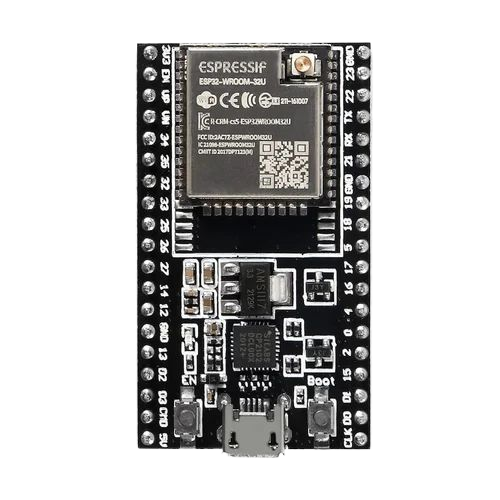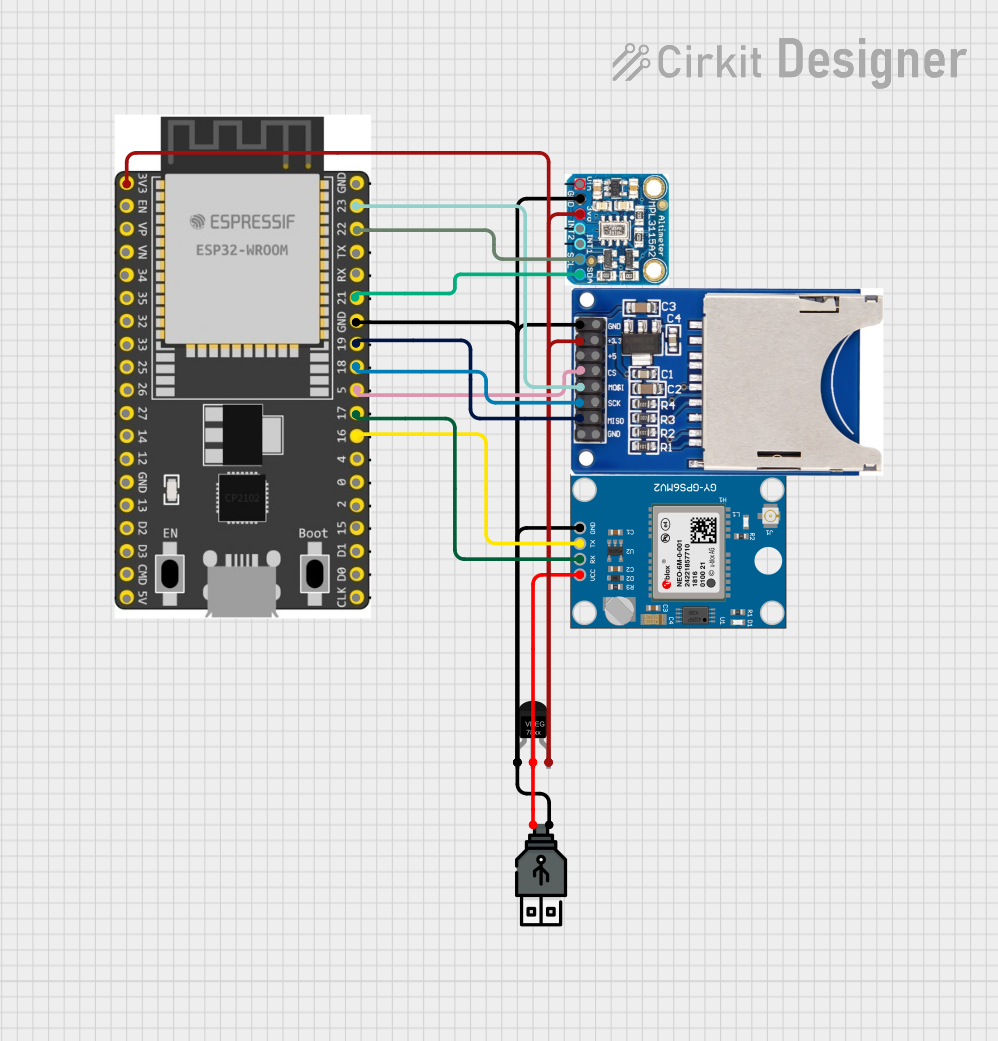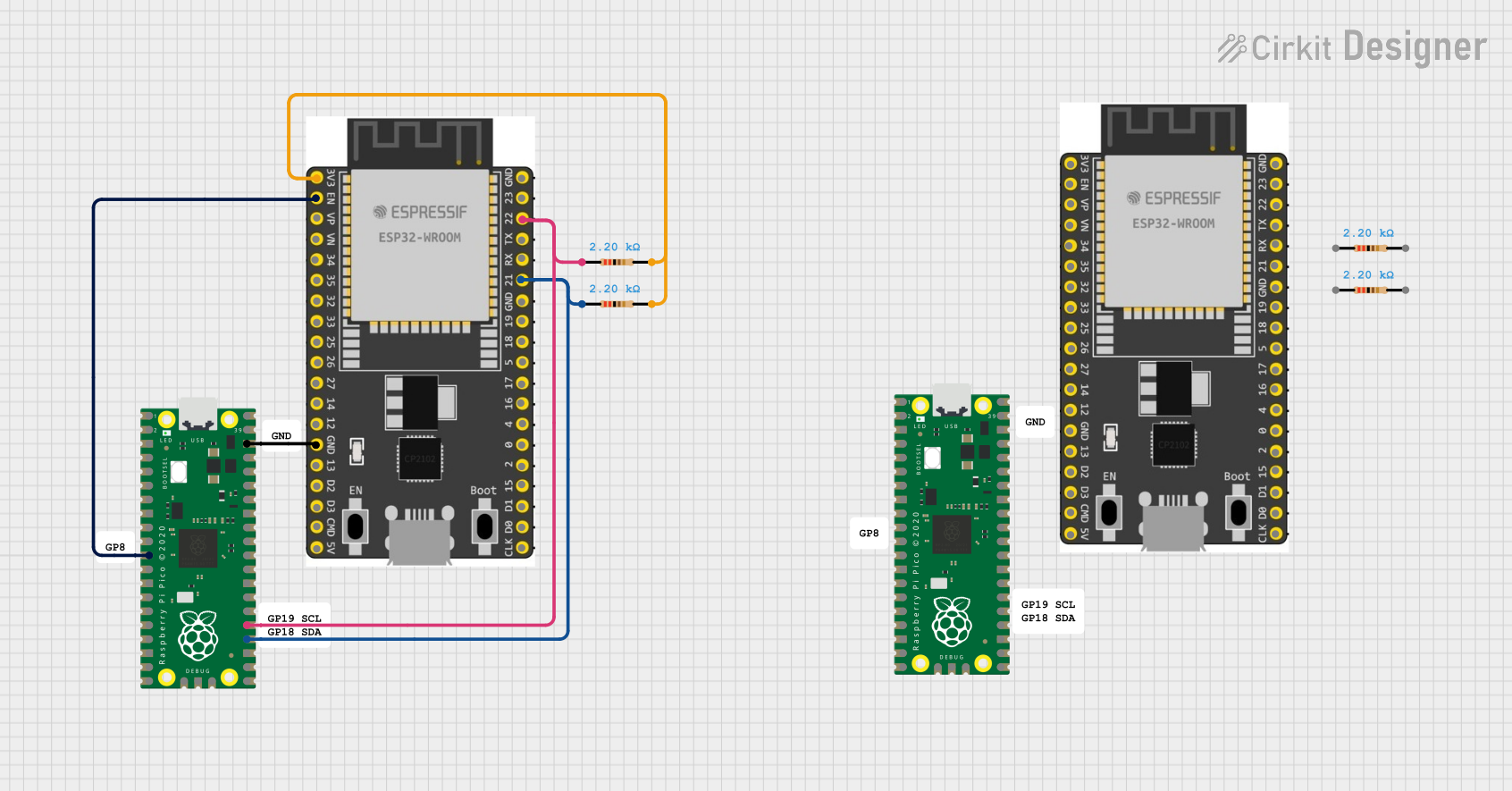
How to Use esp32-wroom 32u 38pins: Examples, Pinouts, and Specs

 Design with esp32-wroom 32u 38pins in Cirkit Designer
Design with esp32-wroom 32u 38pins in Cirkit DesignerIntroduction
The ESP32-WROOM-32U is a high-performance microcontroller module manufactured by Pra with the part ID ESP32. It is designed for IoT (Internet of Things) applications, offering integrated Wi-Fi and Bluetooth capabilities. With its 38 pins, the module provides versatile connectivity options, making it suitable for a wide range of projects, from smart home devices to industrial automation.
Explore Projects Built with esp32-wroom 32u 38pins

 Open Project in Cirkit Designer
Open Project in Cirkit Designer
 Open Project in Cirkit Designer
Open Project in Cirkit Designer
 Open Project in Cirkit Designer
Open Project in Cirkit Designer
 Open Project in Cirkit Designer
Open Project in Cirkit DesignerExplore Projects Built with esp32-wroom 32u 38pins

 Open Project in Cirkit Designer
Open Project in Cirkit Designer
 Open Project in Cirkit Designer
Open Project in Cirkit Designer
 Open Project in Cirkit Designer
Open Project in Cirkit Designer
 Open Project in Cirkit Designer
Open Project in Cirkit DesignerCommon Applications and Use Cases
- IoT Devices: Smart home systems, environmental monitoring, and connected appliances.
- Wearable Technology: Fitness trackers and health monitoring devices.
- Industrial Automation: Remote monitoring and control systems.
- Prototyping and Development: Ideal for hobbyists and engineers working on wireless communication projects.
- Robotics: Wireless control and data transmission for robots and drones.
Technical Specifications
Key Technical Details
| Parameter | Value |
|---|---|
| Manufacturer | Pra |
| Part ID | ESP32 |
| Wireless Connectivity | Wi-Fi 802.11 b/g/n, Bluetooth v4.2 BR/EDR |
| Operating Voltage | 3.0V to 3.6V |
| Flash Memory | 4 MB (default) |
| SRAM | 520 KB |
| GPIO Pins | 38 |
| CPU | Dual-core Xtensa® 32-bit LX6 |
| Clock Speed | Up to 240 MHz |
| Operating Temperature | -40°C to +85°C |
| Dimensions | 18 mm x 25.5 mm |
Pin Configuration and Descriptions
The ESP32-WROOM-32U module has 38 pins, each serving specific functions. Below is the pinout description:
| Pin Number | Pin Name | Function Description |
|---|---|---|
| 1 | EN | Enable pin. Active high to enable the module. |
| 2 | IO0 | GPIO0, used for boot mode selection. |
| 3 | IO1 | GPIO1, UART TXD (default). |
| 4 | IO2 | GPIO2, general-purpose I/O. |
| 5 | IO3 | GPIO3, UART RXD (default). |
| ... | ... | ... |
| 37 | GND | Ground pin. |
| 38 | 3V3 | 3.3V power supply input. |
Note: For the complete pinout, refer to the official datasheet provided by the manufacturer.
Usage Instructions
How to Use the ESP32-WROOM-32U in a Circuit
- Power Supply: Connect the 3.3V pin (Pin 38) to a stable 3.3V power source. Ensure the ground (GND) is connected to the circuit's ground.
- Boot Mode: To upload code, connect GPIO0 (Pin 2) to GND during reset. Disconnect it after uploading.
- Programming: Use a USB-to-Serial adapter to connect the module to your computer. The UART TXD and RXD pins (Pins 3 and 5) are used for communication.
- Peripherals: Connect sensors, actuators, or other peripherals to the GPIO pins as needed. Refer to the pinout table for specific pin functions.
Important Considerations and Best Practices
- Voltage Levels: Ensure all connected devices operate at 3.3V logic levels to avoid damaging the module.
- Antenna Placement: For optimal Wi-Fi and Bluetooth performance, ensure the onboard antenna is not obstructed by metal or other materials.
- Heat Management: If operating in high-temperature environments, consider adding a heatsink or ensuring proper ventilation.
- Firmware Updates: Regularly update the firmware to benefit from performance improvements and bug fixes.
Example: Connecting to an Arduino UNO
The ESP32-WROOM-32U can be programmed using the Arduino IDE. Below is an example code to connect the module to a Wi-Fi network:
#include <WiFi.h> // Include the WiFi library for ESP32
// Replace with your network credentials
const char* ssid = "Your_SSID"; // Your Wi-Fi network name
const char* password = "Your_PASSWORD"; // Your Wi-Fi password
void setup() {
Serial.begin(115200); // Start serial communication at 115200 baud
delay(1000); // Wait for a second
Serial.println("Connecting to Wi-Fi...");
WiFi.begin(ssid, password); // Connect to the Wi-Fi network
// Wait until the ESP32 is connected to Wi-Fi
while (WiFi.status() != WL_CONNECTED) {
delay(500);
Serial.print(".");
}
Serial.println("\nConnected to Wi-Fi!");
Serial.print("IP Address: ");
Serial.println(WiFi.localIP()); // Print the assigned IP address
}
void loop() {
// Add your main code here
}
Tip: Ensure the ESP32 board is selected in the Arduino IDE under Tools > Board.
Troubleshooting and FAQs
Common Issues and Solutions
Module Not Powering On:
- Cause: Insufficient power supply.
- Solution: Ensure the power source provides a stable 3.3V with sufficient current (at least 500mA).
Wi-Fi Connection Fails:
- Cause: Incorrect SSID or password.
- Solution: Double-check the credentials in your code. Ensure the Wi-Fi network is operational.
Code Upload Fails:
- Cause: Incorrect boot mode or serial port settings.
- Solution: Ensure GPIO0 is connected to GND during reset. Verify the correct COM port and baud rate in the Arduino IDE.
Overheating:
- Cause: Prolonged high-performance operation.
- Solution: Add a heatsink or improve ventilation around the module.
FAQs
Q: Can the ESP32-WROOM-32U operate on 5V?
A: No, the module operates at 3.3V. Using 5V can damage the module.Q: How do I reset the module?
A: Pull the EN pin (Pin 1) low momentarily to reset the module.Q: Can I use the ESP32-WROOM-32U with a battery?
A: Yes, ensure the battery provides a stable 3.3V output.Q: Is the module compatible with Bluetooth Low Energy (BLE)?
A: Yes, the ESP32 supports both Bluetooth Classic and BLE.
This documentation provides a comprehensive guide to using the ESP32-WROOM-32U module. For further details, refer to the official datasheet or contact the manufacturer.